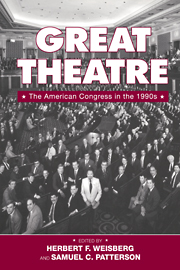Preface
Published online by Cambridge University Press: 20 January 2010
Summary
This book has three major objectives. First and foremost, we intend it as a report on the 104th Congress, the first in forty years to be controlled by the Republican party. Like many of our students, colleagues, and fellow citizens, we have marveled at the historic congressional party change that transpired with the 1994 midterm election. We have sought to account for that change and assay its consequences for the present Congress and for the future. Confirmed by the 1996 congressional elections, the Republican majority and its House and Senate leaders consolidated their dominion, hoping to enjoy an era of congressional hegemony akin to that enjoyed by the Democratic Party for four post–World War II decades.
Congress is the keystone of the American democratic system. In the United States, the legislature truly makes the laws of the land. It is not a rubber stamp for the executive branch. Congress actually is remarkably representative of the American people. It displays their diversity, their strengths and weaknesses, their foibles and indiscretions, and their intelligence and decency. Understanding Congress is an important undertaking in the classrooms, among intellectuals, and within the American citizenry. Where Congress needs to be reformed, effective institutional change requires careful knowledge about how things now work. Knowledge about Congress helps to dispel excessive, myopic, ignorant, and vitriolic negativism about the congressional institution, its members, and its politics.
Our second objective is to set the 104th Congress, meeting in 1995–6, within the perspective of change in Congress in the 1990s more generally. Some of the changes in the 104th Congress had their beginnings in earlier developments.
- Type
- Chapter
- Information
- Great TheatreThe American Congress in the 1990s, pp. xiii - xivPublisher: Cambridge University PressPrint publication year: 1998



